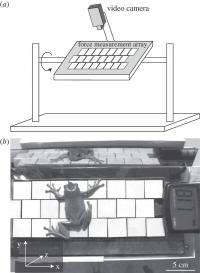January 17, 2013 report
Researchers discover how tree frogs use their bodies to cling to overhanging surfaces (w/ video)

(Phys.org)—A small team of researchers with members from the U.K., China, and Germany has discovered that tree frogs adjust their posture to reduce the angle of their toe pads to avoid falling from an overhanging surface. They have published the results of their study in Journal of the Royal Society Interface.
White's tree frog are able to cling to hard surfaces even when that surface is tilted to a significant degree. They do so by secreting mucus in their toe pads which leads to capillary forces between the frog and surface that hold them together. But they also change their posture depending on how steep the surface is, and until now, the reason for that hasn't been clear.
To learn more, the researchers placed a frog on a tiled surface which itself was affixed to a movable plane. The tiles were also wired to allow for measuring the amount of force between the toe pads and the surface to which they were clinging as the angle of the surface was changed. The experiment involved increasing the angle of the surface and observing the frog's behavior as it strove to hold on.
Remarkably, the team found that the frog could maintain its grip on the surface up to an angle of approximately 150°, which is of course, nearly upside down. More importantly, they found that as the angle of the surface was increased, the frog responded by flattening its body against the surface. In order to do so, it had to extend its limbs. The higher the angle, the more the frog reached out, until eventually reaching its physical limit. The team noted that as the surface was tilted, the forces holding the frog to the surface continually decreased – until the frog adjusted its stance. Doing so, caused the forces to revert back to their original readings. This process was repeated until the frog eventually fell off the tiled wall.
The team likens the approach used by the frog to the way tape is used by us humans. To remove it once applied, one corner is pried away from the surface and then it's gripped and pulled back at a very sharp angle. The sharp angle breaks the bond between the tape and the surface. To continue holding onto the tile, the frog applies the same principle, but in reverse. By minimizing the angle of its toe pads with the surface, the frog is avoiding being ripped off by gravity as the surface angle increases.
More information: Sticking like sticky tape: tree frogs use friction forces to enhance attachment on overhanging surfaces, Journal of the Royal Society Interface, Published online January 16, 2013 doi: 10.1098/rsif.2012.0838
Abstract
To live and clamber about in an arboreal habitat, tree frogs have evolved adhesive pads on their toes. In addition, they often have long and slender legs to facilitate not only long jumps, but also to bridge gaps between leaves when climbing. Both adhesive pads and long limbs are used in conjunction, as we will show in this study. Previous research has shown that tree frogs change from a crouched posture (where the limbs are close to the body) to a sprawled posture with extended limbs when clinging on to steeper inclines such as vertical or overhanging slopes. We investigated this change in posture in White's tree frogs (Litoria caerulea) by challenging the frogs to cling onto a tiltable platform. The platform consisted of an array of 24 three-dimensional force transducers, which allowed us to measure the ground reaction forces of the frogs during a tilt. Starting from a crouched resting position, the normal forces on the forelimbs changed sign and became increasingly negative with increasing slope angle of the platform. At about 106°±12°, tilt of the platform the frogs reacted by extending one or two of their limbs outwards. At a steeper angle (131°±11°), the frogs spread out all their limbs sideways, with the hindlimbs stretched out to their maximum reach. Although the extension was strongest in the lateral direction, limbs were significantly extended in the fore–aft direction as well. With the extension of the limbs, the lateral forces increased relative to the normal forces. The large contribution of the in-plane forces helped to keep the angle between the force vector and the platform small. The Kendall theory for the peeling of adhesive tape predicts that smaller peel angles lead to higher attachment forces. We compare our data with the predictions of the Kendall model and discuss possible implications of the sliding of the pads on the surface. The forces were indeed much larger for smaller angles and thus can be explained by peeling theory.
Journal information: Journal of the Royal Society Interface
© 2013 Phys.org


















